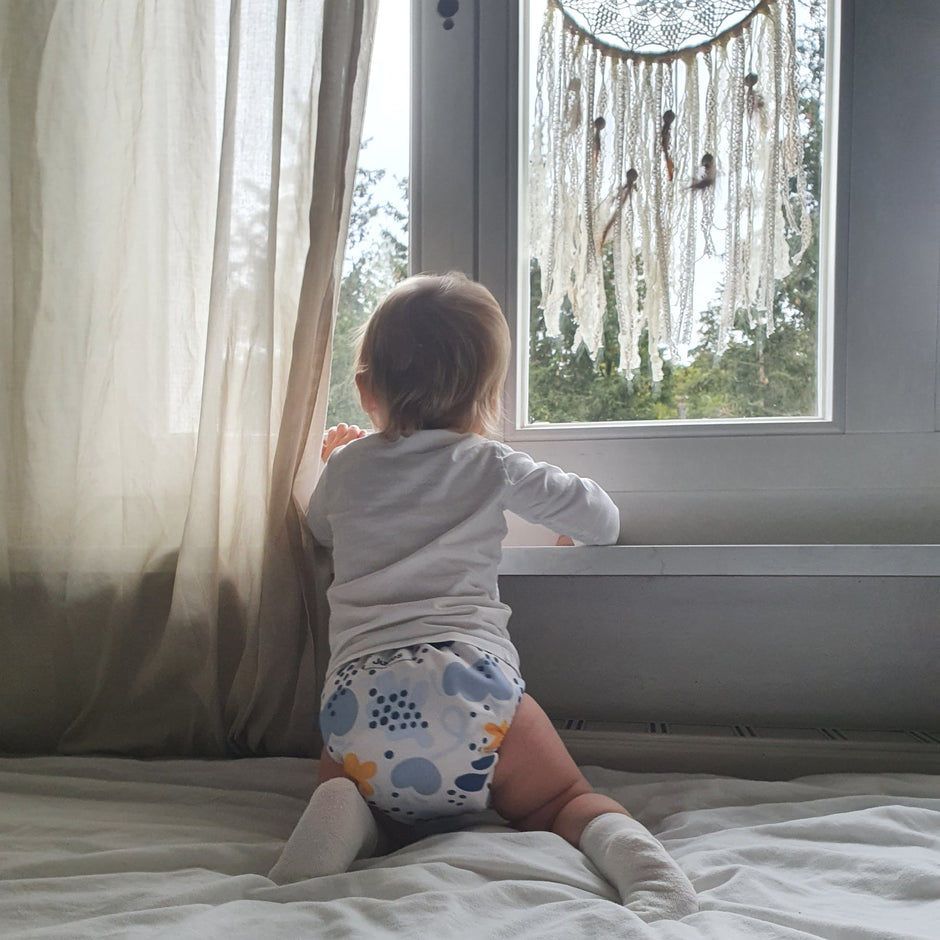Helpful Cloth Diaper Insights: Tips and Tricks for Sustainable Diapering
Updated on:
Photo by @anni.und.die.bande
You may have already heard that cloth diapers are a great alternative to disposable diapers. However, you are probably still unsure about how it all works or whether it's really the right choice for you. Don't worry! This article provides you with plenty of helpful information and tips that will make cloth diapering easier for you.
As mindfulness and sustainability gain more importance, cloth diapers are more than just a retro trend. They are a sign of environmentally conscious behavior and also offer many advantages for you and your baby.
What do I need for cloth diapering? For cloth diapering, you first need a basic set of about 20 to 24 cloth diapers. The amount depends on how often you want to wash the cloth diapers and which system you choose. One or more diaper bags, boosters, and other accessories will significantly ease your everyday life with cloth diapers.
In this article, you will not only learn about the general benefits of cloth diapers. You will also receive valuable tips for everyday life.
The Advantages of Cloth Diapers
Cloth diapers are not just a statement for a more sustainable lifestyle. They also bring a range of benefits that you might not yet be aware of. Let's take a closer look at some of them:
Cloth Diapers are Eco-friendly
The first and most obvious advantage is the eco-friendliness. Did you know that a disposable diaper can take up to 500 years to decompose? Imagine how many diapers a baby uses in the first years of life. Then multiply that by all the babies in the world! It's quite shocking, isn't it? Cloth diapers, on the other hand, are reusable and significantly reduce waste. Additionally, you can resell them later or use them for the next child.
Every Cloth Diaper is Skin-friendly
Cloth diapers are made from natural materials like cotton, hemp, or bamboo. These fabrics are not only soft and comfortable but also breathable. This means less diaper rash and irritation for the sensitive baby skin. Moreover, cloth diapers do not contain any chemicals or fragrances that are found in many disposable diapers.

Photo by @kerstinbrigitteposch
Switching to Cloth Diapers is Cost-effective
The initial investment in cloth diapers can seem daunting at first. However, in the long run, you save a lot of money. Disposable diapers can put a significant strain on the household budget, while cloth diapers are almost free after the initial purchase – apart from the washing costs. Another plus point: You can reuse them for other children or sell them on second-hand. You can find more details about the cost difference between cloth diapers and disposable diapers in our blog.
Promoting Earlier Potty Training
A frequently overlooked but remarkable advantage of cloth diapers is that they can help your child become potty trained earlier. While disposable diapers transport the liquids away from the baby's body and always feel dry, cloth diapers allow your child to feel the wetness a bit more. This is not unpleasant at all but helps your child develop a better awareness of their own body and their needs.
This sensitivity can support the potty training process since your child learns more quickly to recognize and interpret the signals from their body. Many parents report that children who use cloth diapers learn to go to the toilet significantly earlier than children who use disposable diapers. Our study on potty training with cloth diapers is also clear on this.
When children become potty trained early, it has two benefits. Firstly, the diaper-changing effort is minimized, and secondly, your child learns early on to pay attention to their body. In contrast, disposable diapers delay this process by providing the child with a lasting feeling of dryness. As a result, the diapering period extends, leading to high costs due to the purchase of new diapers.
How to Properly Care for Your Cloth Diapers
Cloth diapers are both eco-friendly and gentle on the skin, but they do require special care to ensure longevity and to meet hygienic standards. Don't worry, with the right tips and tricks, it's very easy!
Washing
A key element in the care of cloth diapers is washing. Generally, you should wash cloth diapers after each use to remove bacteria and odors. You can store them temporarily for up to four days. When washing, it is important to use a mild, eco detergent that is free from optical brighteners and fragrances. This helps avoid irritation of the baby's skin. The Judes Family Care detergent is perfectly suited for this and can also be used for your regular laundry. A hot wash cycle (60 °C) is recommended to ensure the diapers are thoroughly cleaned. In our post “How to Gently and Hygienically Wash Your Cloth Diapers,” you will learn everything you need to know about washing cloth diapers.
Drying
Drying cloth diapers is also an important aspect. It's best to let the diapers air dry. This is not only eco-friendly but also effective. The sun has a natural bleaching effect that can remove any stains. If the weather doesn't cooperate or you're in a hurry, you can also dry most cloth diapers in the dryer at a low temperature.
Stain Removal
Yes, stains are part of everyday diapering. But don't worry: with a few simple home remedies like lemon juice or baking soda, most stains can be easily removed. Simply apply the desired home remedy to the stain, let it sit, and wash the diaper as usual. In most cases, the aforementioned trick with the sun is already enough to get rid of most stains.
Caring for cloth diapers is not complicated, but it does require a bit of routine and attention. The reward is a clean, comfortable experience for your baby and the feeling of doing something good for the environment.
Helpful Information on Cloth Diapers: Concerns and Solutions
Are you fascinated by the advantages of cloth diapers but still have concerns? That is completely normal and many parents feel the same way before taking the plunge. Here we address some of the most common questions and fears about the subject of cloth diapers. In our post “The 13 Most Common Beliefs About Cloth Diapers” we have already discussed some myths on the topic.
Are Cloth Diapers Hygienic?
Concerns about hygiene are widespread. Many parents worry that cloth diapers are not as hygienic as disposable diapers. In fact, the opposite is true. If you follow the care tips mentioned above, cloth diapers are at least as hygienic as their disposable counterparts. Furthermore, cloth diapers contain no chemical ingredients that could irritate your baby's skin.
How Do I Prevent Diaper Rash?
The good news is that cloth diapers are made from natural materials and contain fewer chemical irritants. They are more breathable and therefore reduce the risk of diaper rash as well as diaper dermatitis. Additionally, they support the skin’s natural ability to regulate itself – it is naturally able to heal itself. If skin irritation does occur, it is important to change the diapers regularly, ensuring they are thoroughly cleaned and rinsed.
How Many Cloth Diapers Do I Need?
The number of cloth diapers needed can vary depending on how often you want to wash. A common recommendation is to start with about 20 to 25 cloth diapers if you wash every two to three days. This gives you enough leeway in case some diapers are in the wash or still drying.
With the right knowledge and a little practice, you will quickly find that many of these concerns can be easily resolved.
Judes – As Easy as Disposable Diapers and Yet Much Better
When starting with cloth diapers, parents are often looking for a simple and straightforward solution that matches the everyday convenience of disposable diapers. This is why we developed Judes.
Judes cloth diapers consist of just an inner diaper and an outer cover. You don’t need to worry about extensive preparations, matching materials, or folding inserts. In use, Judes are at least as easy as disposable diapers. Due to their sustainable materials, they are much more environmentally, skin, and budget-friendly.
We know: All beginnings are difficult. For beginners, we have created our starter set. In this starter set all the materials you need to start your cloth diaper adventure are included. This way, you can get a good overview and find out if our system is right for you.
And even better: We are so convinced of Judes ourselves that we offer you a 100-day money-back guarantee. If you are not satisfied after thorough testing, you can simply return the diapers.

Additional Accessories for Your Cloth Diaper Adventure
In addition to the cloth diapers themselves, there are some additional accessories that can make your start to diapering even more comfortable and efficient. These helpers are not mandatory, but they can make your everyday life significantly easier.
Diaper Bags
Diaper bags, also known as wet bags, are waterproof bags in which you can store used cloth diapers in a safe and odor-free way. There is the large diaper bag for your changing area at home, and a smaller version for on the go. They come in different sizes and are incredibly practical for day trips or longer excursions. Besides cloth diapers, diaper bags are also great for transporting dirty laundry or swimwear.
Diaper Pail
At home, a special diaper pail for cloth diapers can be a good investment. Although you can easily hang up diaper bags and thus use them without a pail, diaper pails are sometimes the more practical and visually appealing solution. Please note: The diaper pail must provide good ventilation. If diapers are stored airtight, ammonia can quickly form, which can damage the diapers and cause skin irritation despite washing. The latter is referred to as ammonia burn and is characterized by extensive redness in the intimate area.
Booster
As a booster, absorbent and space-saving inserts are used. You place these in the diaper to increase absorbency. They are particularly suitable for heavy wetters, at night, or for longer car rides.
Poo-Paper
Poo-Paper, also known as diaper liner, is a helpful companion in the cloth diaper everyday life starting from the introduction of solid food. It is placed as the top layer in the diaper, catches the stool, and separates it from the diaper. During diaper changes, you can hygienically remove the Poo-Paper including the stool.
Washcloths
Washcloths can replace traditional wet wipes uncompromisingly and sustainably. These small cotton cloths are perfectly sized for appropriate diaper hygiene and are soft and gentle on the skin. Moisten them with warm water to provide your child with a more pleasant changing experience than with cool wet wipes. For sensitive skin, redness, or irritations, you can also add a bit of nourishing oil to the water.
With Judes – and the right accessories – diapering becomes not only more efficient but also more pleasant for you and your baby.

